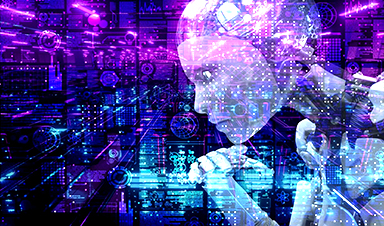A new mathematical model enhances the evaluation of AI identification risks, offering a scalable solution to balance technological benefits with privacy protection.
AI tools are increasingly used to track and monitor people both online and in person, but their effectiveness carries significant risks. To address this, computer scientists from the Oxford Internet Institute, Imperial College London, and UCLouvain have developed a new mathematical model designed to help people better understand the dangers of AI and support regulators in safeguarding privacy. Their findings were published in Nature Communications.
This model is the first to offer a solid scientific framework for evaluating identification methods, particularly when handling large-scale data. It can assess the accuracy of techniques like advertising codes and invisible trackers in identifying online users based on minimal information—such as time zones or browser settings—a process known as "browser fingerprinting."
Lead author Dr. Luc Rocher, Senior Research Fellow, Oxford Internet Institute, part of the University of Oxford, said: "We see our method as a new approach to help assess the risk of re-identification in data release, but also to evaluate modern identification techniques in critical, high-risk environments. In places like hospitals, humanitarian aid delivery, or border control, the stakes are incredibly high, and the need for accurate, reliable identification is paramount."
Leveraging Bayesian Statistics for Improved Accuracy
The method draws on the field of Bayesian statistics to learn how identifiable individuals are on a small scale, and extrapolate the accuracy of identification to larger populations up to 10x better than previous heuristics and rules of thumb. This gives the method unique power in assessing how different data identification techniques will perform at scale, in different applications and behavioral settings. This could help explain why some AI identification techniques perform highly accurately when tested in small case studies but then misidentify people in real-world conditions.
The findings are highly timely, given the challenges posed to anonymity and privacy caused by the rapid rise of AI-based identification techniques. For instance, AI tools are being trialed to automatically identify humans from their voice in online banking, their eyes in humanitarian aid delivery, or their face in law enforcement.
According to the researchers, the new method could help organizations to strike a better balance between the benefits of AI technologies and the need to protect people's personal information, making daily interactions with technology safer and more secure. Their testing method allows for the identification of potential weaknesses and areas for improvement before full-scale implementation, which is essential for maintaining safety and accuracy.
A Crucial Tool for Data Protection
Co-author Associate Professor Yves-Alexandre de Montjoye (Data Science Institute, Imperial College, London) said: "Our new scaling law provides, for the first time, a principled mathematical model to evaluate how identification techniques will perform at scale. Understanding the scalability of identification is essential to evaluate the risks posed by these re-identification techniques, including to ensure compliance with modern data protection legislations worldwide."
Dr. Luc Rocher concluded: "We believe that this work forms a crucial step towards the development of principled methods to evaluate the risks posed by ever more advanced AI techniques and the nature of identifiability in human traces online. We expect that this work will be of great help to researchers, data protection officers, ethics committees, and other practitioners aiming to find a balance between sharing data for research and protecting the privacy of patients, participants, and citizens."
Reference: "A scaling law to model the effectiveness of identification techniques" by Luc Rocher, Julien M. Hendrickx and Yves-Alexandre de Montjoye, 9 January 2025, Nature Communications.
DOI: 10.1038/s41467-024-55296-6
The work was supported by a grant awarded to Luc Rocher by Royal Society Research Grant RG\R2\232035, the John Fell OUP Research Fund, the UKRI Future Leaders Fellowship [grant MR/Y015711/1], and by the F.R.S.-FNRS. Yves -Alexandre de Montjoye acknowledges funding from the Information Commissioner Office.
News
Scientists Unlock a New Way to Hear the Brain’s Hidden Language
Scientists can finally hear the brain’s quietest messages—unlocking the hidden code behind how neurons think, decide, and remember. Scientists have created a new protein that can capture the incoming chemical signals received by brain [...]
Does being infected or vaccinated first influence COVID-19 immunity?
A new study analyzing the immune response to COVID-19 in a Catalan cohort of health workers sheds light on an important question: does it matter whether a person was first infected or first vaccinated? [...]
We May Never Know if AI Is Conscious, Says Cambridge Philosopher
As claims about conscious AI grow louder, a Cambridge philosopher argues that we lack the evidence to know whether machines can truly be conscious, let alone morally significant. A philosopher at the University of [...]
AI Helped Scientists Stop a Virus With One Tiny Change
Using AI, researchers identified one tiny molecular interaction that viruses need to infect cells. Disrupting it stopped the virus before infection could begin. Washington State University scientists have uncovered a method to interfere with a key [...]
Deadly Hospital Fungus May Finally Have a Weakness
A deadly, drug-resistant hospital fungus may finally have a weakness—and scientists think they’ve found it. Researchers have identified a genetic process that could open the door to new treatments for a dangerous fungal infection [...]
Fever-Proof Bird Flu Variant Could Fuel the Next Pandemic
Bird flu viruses present a significant risk to humans because they can continue replicating at temperatures higher than a typical fever. Fever is one of the body’s main tools for slowing or stopping viral [...]
What could the future of nanoscience look like?
Society has a lot to thank for nanoscience. From improved health monitoring to reducing the size of electronics, scientists’ ability to delve deeper and better understand chemistry at the nanoscale has opened up numerous [...]
Scientists Melt Cancer’s Hidden “Power Hubs” and Stop Tumor Growth
Researchers discovered that in a rare kidney cancer, RNA builds droplet-like hubs that act as growth control centers inside tumor cells. By engineering a molecular switch to dissolve these hubs, they were able to halt cancer [...]
Platelet-inspired nanoparticles could improve treatment of inflammatory diseases
Scientists have developed platelet-inspired nanoparticles that deliver anti-inflammatory drugs directly to brain-computer interface implants, doubling their effectiveness. Scientists have found a way to improve the performance of brain-computer interface (BCI) electrodes by delivering anti-inflammatory drugs directly [...]
After 150 years, a new chapter in cancer therapy is finally beginning
For decades, researchers have been looking for ways to destroy cancer cells in a targeted manner without further weakening the body. But for many patients whose immune system is severely impaired by chemotherapy or radiation, [...]
Older chemical libraries show promise for fighting resistant strains of COVID-19 virus
SARS‑CoV‑2, the virus that causes COVID-19, continues to mutate, with some newer strains becoming less responsive to current antiviral treatments like Paxlovid. Now, University of California San Diego scientists and an international team of [...]
Lower doses of immunotherapy for skin cancer give better results, study suggests
According to a new study, lower doses of approved immunotherapy for malignant melanoma can give better results against tumors, while reducing side effects. This is reported by researchers at Karolinska Institutet in the Journal of the National [...]
Researchers highlight five pathways through which microplastics can harm the brain
Microplastics could be fueling neurodegenerative diseases like Alzheimer's and Parkinson's, with a new study highlighting five ways microplastics can trigger inflammation and damage in the brain. More than 57 million people live with dementia, [...]
Tiny Metal Nanodots Obliterate Cancer Cells While Largely Sparing Healthy Tissue
Scientists have developed tiny metal-oxide particles that push cancer cells past their stress limits while sparing healthy tissue. An international team led by RMIT University has developed tiny particles called nanodots, crafted from a metallic compound, [...]
Gold Nanoclusters Could Supercharge Quantum Computers
Researchers found that gold “super atoms” can behave like the atoms in top-tier quantum systems—only far easier to scale. These tiny clusters can be customized at the molecular level, offering a powerful, tunable foundation [...]
A single shot of HPV vaccine may be enough to fight cervical cancer, study finds
WASHINGTON -- A single HPV vaccination appears just as effective as two doses at preventing the viral infection that causes cervical cancer, researchers reported Wednesday. HPV, or human papillomavirus, is very common and spread [...]





















